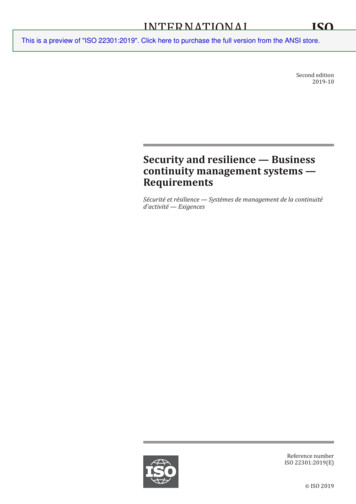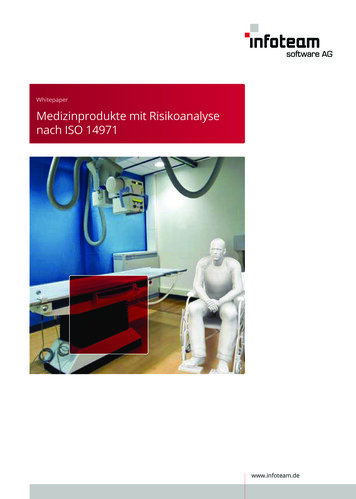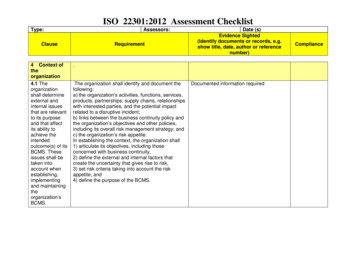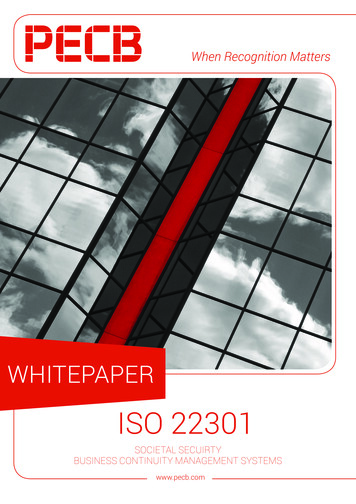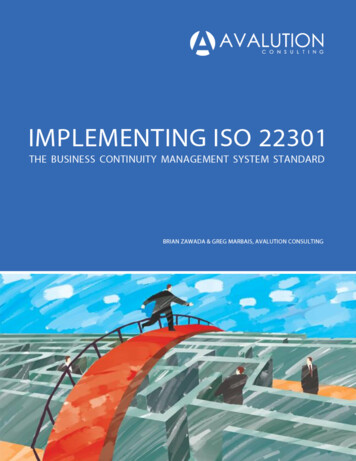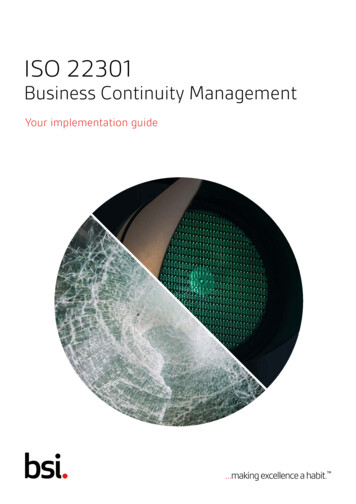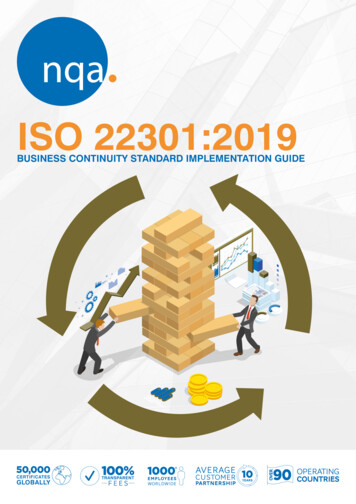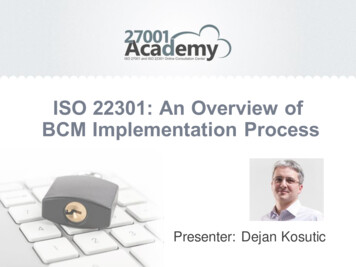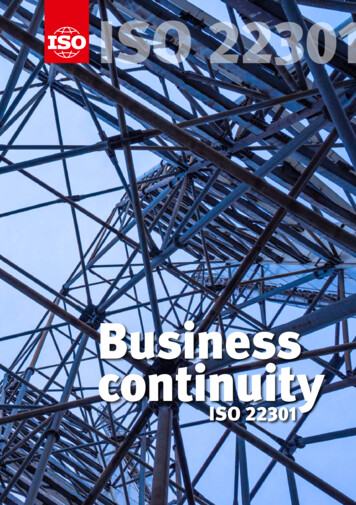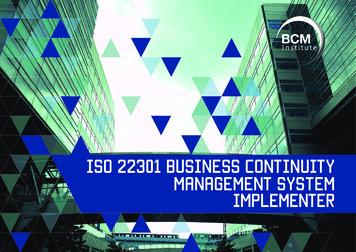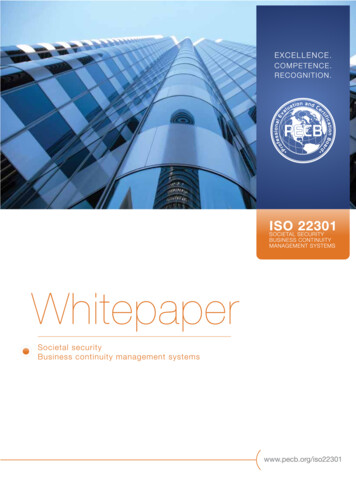
Transcription
Princi al authorsRené St-GERMAIN, PECB (France)Faton ALIU, PECB (Canada)Eric LACHAPELLE , PECB (Canada)Pierre DEWEZ , Devoteam (Belgium)ontributorsIan BELL (UK)Yannick BERNERON, Egyde (Canada)Daniela CATALIN, IT Academy (Romania)Goran CHAMUROVSKI, INTEGRA Solution (Macedonia)Jacques CHENEVIERE, Devoteam (France)Marcelo CORREA, Behaviour (Brasil)Karsten M. DECKER, Decker Consulting (Switzerland)Jérôme FERRU, Devoteam (France)Karim HAMDAOUI, LMPS Consulting (Morocco)Emile KOK, TSTC (Netherlands)Mathieu LACHAINE, Kereon (Canada)Jan MAES, Devoteam (Belgium)Simona MOSTEANU (Belgium)Graeme PARKER, Parker Solutions (UK)Dirk PAUWELS, Devoteam (Belgium)Joaquim PEREIRA, Behaviour (Portugal)Sébastien RABAUD, SCASSI (France)Itzhak SHARON, GSECTRA (Israel)François TÊTE, Devoteam (France)Gilles TROUESSIN, SCASSI (France)Alexandrine VILLE, SEKOIA (France)Richard G. WILSHER, Zygma (USA)ContentsIntroduction.4An overview of ISO 22301:2012.5Key clauses of ISO 22301:2012.5Link between ISO 22301 and other standards.9Link with other business continuity standards.9Link with ISO 27001.10Integration with other management ystes.11Business Continuity Management - The Business Benefits.12Implementation of a BCMS with IMS2 methodology.13Certification of organizations.15Training and certifications of professionals .162 PECB ISO 22301
IntroductionRecent natural disasters, environmental accidents,technology mishaps and man-made crises havedemonstrated that severe incidents can and will happen,impacting the public and private sectors alike. Thechallenge goes beyond providing an emergency response plan orusing disaster management strategies that were previously used.Organizations of all sizes and types should now engage in acomprehensive and systematic process of prevention, protection,preparedness, mitigation, response for business continuityand recovery. It is no longer enough to draft a response planthat anticipates and minimizes the consequences of naturally,accidentally, or intentionally caused disruptions, but ratherorganizations must also take adaptive and proactive measuresto reduce the likelihood of a disruption. Today’s threats requirethe creation of an on-going, managed process that ensuresthe survival and sustainability of an organization’s core activitiesbefore, during, and after a disruptive event.The ability of an organization to recover from a disaster is directlyrelated to the degree of business continuity planning that hastaken place BEFORE the disaster. Studies show that two out offive businesses that experience a disaster will go out of businesswithin five years of the event.Business continuity plans are critical to the continuous operation ofall types of businesses. More importantly, these plans are assumingincreased importance as companies become increasingly relianton technology to do business.According to research by the META Group,the potential financial loss due to downtimeis staggering. For an online retailer, the hourlyloss is over one million dollars, on average.For a financial institution, the average hourlyloss is closer to 1.5 million. And for utilitycompanies such as telecommunicationsand energy, the potential loss can reach ashigh as 2.8 million per hour. That’s over 67million in a day. Or, 24.5 billion per year.Despite this clear message that downtime is disastrous, Gartnerresearch shows that less than 30 percent of Fortune 2000companies have invested in a full business continuity plan. Thereason for this oversight may simply be that the technical challengesseem to be too daunting. Or perhaps the cost of implementation isperceived as too great. All of these are viable concerns, but theycan be addressed with business continuity solutions.ISO 22301, the world’s first international standard for BusinessContinuity Management (BCM), has been developed to helporganizations minimize the risk of such disruptions. ISO has officiallylaunched ISO 22301, “Societal security - Business continuitymanagement systems – Requirements”, the new internationalstandard for Business Continuity Management System (BCMS).This standard will replace the current British standard BS 25999.PECB ISO22301 3
An overview of ISO 22301:2012ISO 22301 specifies requirements to plan, establish, implement, operate, monitor, review, maintain and continually improvea documented management system to prepare for, respond to and recover from disruptive events when they arise.The requirements specified in ISO 22301 are generic and intended to be applicable to all organizations (or parts thereof),regardless of type, size and nature of the organization. The extent of application of these requirements depends on theorganization’s operating environment and complexity.Business continuity standardization evolves with ISO22301 by adding:Greater emphasis on setting the objectives, monitoringperformance and metrics;Clearer expectations on management;More careful planning for and preparing theresources needed for ensuring business continuity;ISO 22301 applies to all types and sizes of organizationsthat wish to:1. establish, implement, maintain and improve a BCMS;2. assure conformity with the organization’s stated businesscontinuity policy;3. demonstrate conformity to others;4. seek certification/registration of its BCMS by anaccredited third party certification body; or5. make a self-determination and self-declaration ofconformity with this International Standard.What is Business ContinuityManagement?BCM is a holistic management process thatidentifies potential threats to an organizationand the impacts to business operationsthose threats, if realized, might cause, andwhich provides a framework for buildingorganizational resilience with the capabilityfor an effective response that safeguards theinterests of its key stakeholders, reputation,brand and value-creating activitiesISO 22301 is the first standard to be fully compliant with thenew guidelines from ISO/Guide 83 (“High level structure andidentical text for management system standards and commoncore management system terms and definitions”). It has been developed in response to standards users’ critics that, whilecurrent standards have many common components, they are not sufficiently aligned, making it difficult for organizations torationalize their systems and to interface and integrate them.This means that ISO 22301 will be the first standard to fully integrate a high-level structure and common text that will makeit totally aligned with all other management systems once the related standards have also adopted the ISO Guide 83guidelines.Key clauses of ISO 22301:2012Following the new structure of the ISO Guide 83, ISO 22301 is organized into the following main clauses:Clause 4: Context of the organizationClause 5: LeadershipClause 6: PlanningClause 7: SupportClause 8: OperationClause 9: Performance evaluationClause 10: ImprovementEach of these key activities is listed below.4 PECB ISO22301
Clause 4: Context of the organizationValues ValuesDetermine external and internal issues that are relevant to its purpose and that affect its ability to achieve the expectedoutcomes of its BCMS such as:the organization’s activities, functions, services, products, partnerships, supply chains, relationships with interestedparties, and the potential impact related to a disruptive incident;links between the business continuity policy andthe organization’s objectives and other policies,Missionincluding its overall risk management strategy;BU S INESSthe organization’s risk appetite;Strategic AlignmentC O N TINUITYValuesValuesValuesthe needs and expectations of relevantO BJE C T IVESinterested parties;Objectivesapplicable legal, regulatory and otherrequirements to which the organizationsubscribes.Identifying the scope of the BCMS, taking intoCorporate Policyaccount the organization’s strategic objectives,key products and services, risk tolerance, and anyregulatory, contractual or stakeholder obligations is also part of this clause.Business Continuity Policy Clause 5: LeadershipTop management needs to demonstrate an ongoing commitment to the BCMS. Through its leadership and actions,management can create an environment in which different actors are fully involved and in which the management systemcan operate effectively in synergy with the objectives of the organization. They are responsible for:ensuring the BCMS is compatible with the strategic direction of the organization;integrating the BCMS requirements into the organization’s business processes;providing the necessary resources for the BCMS;communicating the importance of effective business continuity management;ensuring that the BCMS achieves its expected outcomes;directing and supporting continual improvement;establish and communicate a business continuity policy;ensuring that BCMS objectives and plans are established;ensuring that the responsibilities and authorities for relevant roles are assigned. Clause 6: PlanningThis is a critical stage as it relates to establishing strategic objectives and guiding principles for the BCMS as a whole. Theobjectives of a BCMS are the expression of the intent of the organization to treat the risks identified and/or to comply withrequirements of organizational needs. The business continuity objectives must:be consistent with the business continuity policy;take into account the minimum level of products and services that is acceptable to the organization to achieve itsobjectives;be measurable;take into account applicable requirements;be monitored and updated as appropriate. Clause 7: SupportThe day-to-day management of an effective business continuity management system relies on using the appropriateresources for each task. These include competent staff with relevant (and demonstrable) training and supporting services,awareness and communication. This must be supported by properly managed documented information.Both internal and external communications of the organization must be considered in this area, including the format, thecontent and the proper timing of such communications.The requirements on the creation, update and control of documented information are also specified in this clause.PECB ISO22301 5
Clause 8: Operation After planning the BCMS, an organization must put it in operation.This clause includes:Business Impact Analysis (BIA): This activity enables an organization to identify the critical processes that support its keyproducts and services, the interdependencies between processes and the resources required to operate the processes at aminimally-acceptable level.Risk assessment: ISO 22301 proposes to referto the ISO 31000 standard to implement thatprocess. The goal of this requirement is to establish,implement, and maintain a formal documented riskassessment process that systematically identifies,analyzes, and evaluates the risk of disruptiveincidents to the organization.Process of analysingbusiness functionsand the effect thatthe business disruption might haveupon themBUS IN E S SCON TIN UIT YAN ALYS ISRIS KAS S E S S M E N TOverall process of riskidentification,risk analysis andrisk evaluation Business continuity strategy: After requirements have been established through the BIA and the risk assessment, strategiescan be developed to identify arrangements that will enable the organization to protect and recover critical activities based onorganizational risk tolerance and within defined recovery time objectives. Experience and good practice clearly indicate that theearly provision of an overall organizational BCM strategy will ensure BCM activities are aligned with and support the organization’soverall business strategy. The business continuity strategy should be an integral component of an institution’s corporate strategy. Business continuity procedures: The organization shall document procedures (including necessary arrangements) to ensurecontinuity of activities and management of a disruptive incident. The procedures have to:o establish an appropriate internal and external communications protocol;o be specific regarding the immediate steps that are to be taken during a disruption;o be flexible to respond to unanticipated threats and changing internal and external conditions;o focus on the impact of events that could potentially disrupt operations;o be developed based on stated assumptions and an analysis of interdependencies; and;o be effective in minimizing consequences through implementation of appropriate mitigation strategies. Exercising and testing: To ensure that business continuity procedures are consistent with its
ISO 22301 specifies requirements to plan, establish, implement, operate, monitor, review, maintain and continually improve a documented management system to prepare for, respond to and recover from disruptive events when they arise. The requirements specified in ISO 22301 are generic and intended to be applicable to all organizations (or parts thereof), regardless of type, size and nature of .

